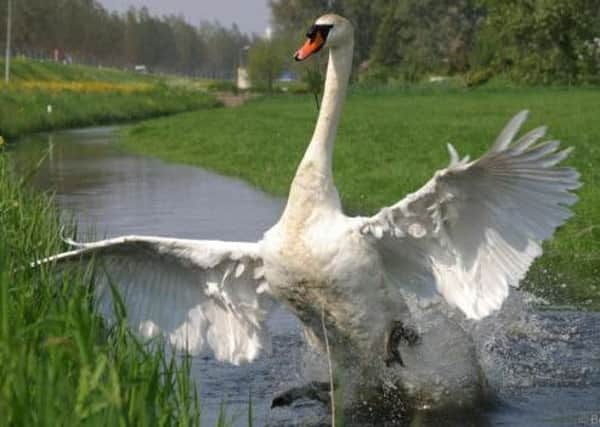Country Diary: The perils of facing up to a '˜busking' swan


The naked earth crouched shuddering at his feet –
From ‘Winter’ by Frances Anne Kemble.
It was a grim forecast as we travelled to Driffield. Then just beyond Langtoft we spotted a party of five redwing feeding on the grass verge beneath hawthorn bushes. These Scandinavian migrants are the smallest of our thrushes, and are also the most susceptible to hard frosts or deep snow. As they stood, their dull red flanks were visible, along with pale cream stripes on the face, and distinctive streaks across the almost white breast.
Visiting Driffield to view King’s Mill and Bell Mills water-ways, all was quiet. Only mute swans and mallard were observed.
Advertisement
Hide AdAdvertisement
Hide AdLittle Driffield proved a similar situation, as we parked beside the village pond for a warming flask of tea. Apart from mallard, a couple of strange mute swans were noted. One close by appeared to have a damaged left wing. Its feathers had been ripped off, and its wings trailed to one side.
The other swan was standing on a cottage’s door-step as though patiently waiting to be fed. Viewing it through binoculars, revealed that this bird also carried a deformed or damaged left wing. Both appeared perfectly healthy. We know that aggressive males will chase off intruders, flying and then swimming quickly towards them. Could this be the result of a serious fight? Such behaviour is called ‘busking’. With arched wings, breast thrust forwards, head curved back, and neck feathers fluffed out, battle may commence!
As previously mentioned, the earliest flowers of the new year are appearing. Winter heliotrope is growing in profusion in Scalby village. Below the church a colony of heart-shaped leaves carpet the ground on embankments of the beck along Carr Lane. Spikes of pale lilac flowers emit the perfume of vanilla.
We’ve discovered another bush of the spindle tree. Look beside the path skirting Peasholm Park little paddling and boating pool. It’s now devoid of leaves and fruits, so check the twigs. If they’re narrow, green, and feel square-stemmed, it’s possibly spindle.
Advertisement
Hide AdAdvertisement
Hide AdMost folk are familiar with the gigantic chile pine, or monkey puzzle tree. Attaining a height of 100-130ft, and a diameter of 3-6ft for the trunk, it’s a native of Central and Southern Chile, and West Argentina. It’s described as a living fossil because of its longevity. Having branches like a candelabra, and stiff, sharp leaves persisting for 10-15 years, it requires space!
It’s early cultivation in Britain was c1850 as a rarity. Sir William Molesworth owned a young specimen at Pencarrow near Bodmin, Cornwall. Showing it to friends, Charles Austin remarked, “It would puzzle a monkey to climb that!”
A bungalow on Scalby Road now has a monkey puzzle reduced to a tree trunk. Seated, is a fine, sculpted monkey with long tail. Splendid!